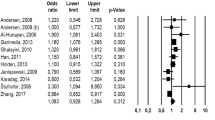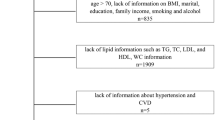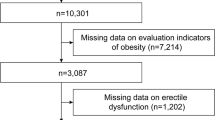Abstract
Background
Currently, a growing number of research studies have shown a positive association between obesity and erectile dysfunction, while traditional anthropometric measures, such as BMI, have limited ability to assess the risk of erectile dysfunction. Therefore, this study aimed to investigate the association between the new anthropometric index and erectile dysfunction.
Methods
A study involving 3594 participants from the National Health and Nutrition Examination Survey was conducted. The study calculated various anthropometric indices such as waist circumference (WC), waist-to-height ratio (WtHR), body mass index (BMI), a body shape index (ABSI), conicity index (CI), and body roundness index (BRI). The relationship between anthropometric indices and erectile dysfunction (ED) was investigated using multivariate logistic regression and restricted cubic splines (RCS). Interaction analysis was conducted on subgroups to confirm the findings. Additionally, the efficacy of various anthropometric indicators in predicting the risk of erectile dysfunction was assessed using the receiver operating characteristic curve (ROC).
Results
After adjusting for potential confounding factors, we identified a positive and independent correlation between erectile dysfunction (ED) and all other anthropometric measures except for BMI. Additionally, the risk of ED increased by 49% and 42% for each standard deviation increment in ABSI and CI, respectively. Dose—response curve analysis demonstrated that WC, BMI, WtHR, and CI displayed a non-linear correlation with the risk of ED. The subgroup analysis revealed that individuals classified as White, who had higher levels of WC, ABSI, and CI, were more susceptible to erectile dysfunction compared to people from other races. ROC analysis showed that ABSI was superior in detecting erectile dysfunction (area under the curve: 0.750; 95% CI 0.732–0.768; optimal cutoff value: 0.083) as compared to other indices. The combination of obesity defined by BMI and other anthropometric measures showed that higher ABSI and CI levels were positively associated with the prevalence of erectile dysfunction, independent of BMI (P < .001).
Conclusion
In this study, anthropometric indicators including ABSI, BRI, WtHR, CI, and WC were positively associated with erectile dysfunction. To improve the prevention and treatment of this condition, it is recommended that new anthropometric indicators receive greater consideration.



Similar content being viewed by others
Data availability
The datasets generated and analyzed for this study are available at the 2001–2004 NHANES Datasets website (https://wwwn.cdc.gov/nchs/nhanes).
References
Eid JF, Nehra A, Andersson KE et al (2000) First International Conference on the management of erectile dysfunction. Overview consensus statement. Int J Impot Res 12 Suppl 4:S2-5. https://doi.org/10.1038/sj.ijir.3900600
Selvin E, Burnett AL, Platz EA (2007) Prevalence and risk factors for erectile dysfunction in the US. Am J Med 120(2):151–157. https://doi.org/10.1016/j.amjmed.2006.06.010
Johannes CB, Araujo AB, Feldman HA et al (2000) Incidence of erectile dysfunction in men 40 to 69 years old: longitudinal results from the massachusetts male aging study. J Urol 163(2):460–463
Ponholzer A, Temml C, Mock K et al (2005) Prevalence and risk factors for erectile dysfunction in 2869 men using a validated questionnaire. Eur Urol 47(1):80–85. https://doi.org/10.1016/j.eururo.2004.08.017
Andersson DP, Trolle Lagerros Y, Grotta A et al (2017) Association between treatment for erectile dysfunction and death or cardiovascular outcomes after myocardial infarction. Heart 103(16):1264–1270. https://doi.org/10.1136/heartjnl-2016-310746
Zhong L, Ding W, Zeng Q et al (2020) Sodium tanshinone iia sulfonate attenuates erectile dysfunction in rats with hyperlipidemia. Oxid Med Cell Longev 2020:7286958. https://doi.org/10.1155/2020/7286958
Yafi FA, Jenkins L, Albersen M et al (2016) Erectile dysfunction. Nat Rev Dis Primers 2(1):1–20. https://doi.org/10.1038/nrdp.2016.3
Pizzol D, Smith L, Fontana L et al (2020) Associations between body mass index, waist circumference and erectile dysfunction: a systematic review and meta-analysis. Rev Endocr Metab Disord 21(4):657–666. https://doi.org/10.1007/s11154-020-09541-0
Janiszewski PM, Janssen I, Ross R (2009) Abdominal obesity and physical inactivity are associated with erectile dysfunction independent of body mass index. J Sex Med 6(7):1990–1998. https://doi.org/10.1111/j.1743-6109.2009.01302.x
Janssen I, Katzmarzyk PT, Ross R (2004) Waist circumference and not body mass index explains obesity-related health risk. Am J Clin Nutr 79(3):379–384. https://doi.org/10.1093/ajcn/79.3.379
Ashwell M, Gunn P, Gibson S (2012) Waist-to-height ratio is a better screening tool than waist circumference and bmi for adult cardiometabolic risk factors: systematic review and meta-analysis. Obes Rev 13(3):275–286. https://doi.org/10.1111/j.1467-789X.2011.00952.x
Krakauer NY, Krakauer JC (2012) A new body shape index predicts mortality hazard independently of body mass index. PLoS ONE 7(7):e39504. https://doi.org/10.1371/journal.pone.0039504
Biolo G, Girolamo FGD, Breglia A et al (2015) Inverse relationship between “a Body Shape Index” (ABSI) and fat-free mass in women and men: insights into mechanisms of sarcopenic obesity. Clin Nutr 34(2):323–327. https://doi.org/10.1016/j.clnu.2014.03.015
Thomas DM, Bredlau C, Bosy-Westphal A et al (2013) Relationships between body roundness with body fat and visceral adipose tissue emerging from a new geometrical model. Obesity 21(11):2264–2271. https://doi.org/10.1002/oby.20408
Liu Y, Liu X, Guan H et al (2021) Body roundness index is a superior obesity index in predicting diabetes risk among hypertensive patients: a prospective cohort study in China. Front Cardiovasc Med 8:736073. https://doi.org/10.3389/fcvm.2021.736073
Valdez R (1991) A simple model-based index of abdominal adiposity. J Clin Epidemiol 44(9):955–956. https://doi.org/10.1016/0895-4356(91)90059-I
Motamed N, Perumal D, Zamani F et al (2015) Conicity index and waist-to-hip ratio are superior obesity indices in predicting 10-year cardiovascular risk among men and women. Clin Cardiol 38(9):527–534. https://doi.org/10.1002/clc.22437
Derby CA, Araujo AB, Johannes CB et al (2000) Measurement of erectile dysfunction in population-based studies: the use of a single question self-assessment in the massachusetts male aging study. Int J Impot Res 12(4):197–204. https://doi.org/10.1038/sj.ijir.3900542
Liu Y, Hu X, Xiong M et al (2023) Association of BMI with erectile dysfunction: a cross-sectional study of men from an andrology clinic. Front Endocrinol (Lausanne) 14:1135024. https://doi.org/10.3389/fendo.2023.1135024
Janiszewski PM, Janssen I, Ross R (2009) Abdominal obesity and physical inactivity are associated with erectile dysfunction independent of body mass index. J Sex Med 6(7):1990–1998. https://doi.org/10.1111/j.1743-6109.2009.01302.x
Yassin AA, Nettleship JE, Salman M et al (2017) Waist circumference is superior to weight and bmi in predicting sexual symptoms, voiding symptoms and psychosomatic symptoms in men with hypogonadism and erectile dysfunction. Andrologia. https://doi.org/10.1111/and.12634
Riedner CE, Rhoden EL, Ribeiro EP et al (2006) Central obesity is an independent predictor of erectile dysfunction in older men. J Urol 176(4 Pt 1):1519–1523. https://doi.org/10.1016/j.juro.2006.06.049
Lue TF (2000) Erectile dysfunction. N Engl J Med 342(24):1802–1813. https://doi.org/10.1056/NEJM200006153422407
Burnett AL (1997) Nitric oxide in the penis: physiology and pathology. J Urol 157(1):320–324
Hutley L, Prins JB (2005) Fat as an endocrine organ: relationship to the metabolic syndrome. Am J Med Sci 330(6):280–289. https://doi.org/10.1097/00000441-200512000-00005
Trayhurn P, Wood IS (2004) Adipokines: inflammation and the pleiotropic role of white adipose tissue. Br J Nutr 92(3):347–355. https://doi.org/10.1079/bjn20041213
Lyon CJ, Law RE, Hsueh WA (2003) Minireview: adiposity, inflammation, and atherogenesis. Endocrinology 144(6):2195–2200. https://doi.org/10.1210/en.2003-0285
Jang Y, Kim OY, Ryu HJ et al (2003) Visceral fat accumulation determines postprandial lipemic response, lipid peroxidation, dna damage, and endothelial dysfunction in nonobese korean men. J Lipid Res 44(12):2356–2364. https://doi.org/10.1194/jlr.M300233-JLR200
Erectile Physiological and Pathophysiological Pathways Involved in Erectile Dysfunction. J Urol. https://www.auajournals.org/doi/https://doi.org/10.1097/01.ju.0000075362.08363.a4. Accessed 2023–05–23.
Allen NE, Appleby PN, Davey GK et al (2002) Lifestyle and nutritional determinants of bioavailable androgens and related hormones in british men. Cancer Causes Control 13(4):353–363. https://doi.org/10.1023/a:1015238102830
Aggerholm AS, Thulstrup AM, Toft G et al (2008) Is overweight a risk factor for reduced semen quality and altered serum sex hormone profile? Fertil Steril 90(3):619–626. https://doi.org/10.1016/j.fertnstert.2007.07.1292
Corona G, Mannucci E, Fisher AD et al (2008) Low levels of androgens in men with erectile dysfunction and obesity. J Sex Med 5(10):2454–2463. https://doi.org/10.1111/j.1743-6109.2008.00856.x
Yassin A, Nettleship JE, Talib RA et al (2016) Effects of testosterone replacement therapy withdrawal and re-treatment in hypogonadal elderly men upon obesity, voiding function and prostate safety parameters. Aging Male 19(1):64–69. https://doi.org/10.3109/13685538.2015.1126573
Williams G (2012) Aromatase up-regulation, insulin and raised intracellular oestrogens in men, induce adiposity, metabolic syndrome and prostate disease, via aberrant er-α and gper signalling. Mol Cell Endocrinol 351(2):269–278. https://doi.org/10.1016/j.mce.2011.12.017
Traish AM, Munarriz R, O’Connell L et al (2003) Effects of medical or surgical castration on erectile function in an animal model. J Androl 24(3):381–387. https://doi.org/10.1002/j.1939-4640.2003.tb02686.x
Inman BA, Sauver JLS, Jacobson DJ et al (2009) A population-based, longitudinal study of erectile dysfunction and future coronary artery disease. Mayo Clin Proc 84(2):108–113. https://doi.org/10.4065/84.2.108
Thompson IM, Tangen CM, Goodman PJ et al (2005) Erectile dysfunction and subsequent cardiovascular disease. JAMA 294(23):2996–3002. https://doi.org/10.1001/jama.294.23.2996
Foresta C, Caretta N, Lana A et al (2006) Reduced number of circulating endothelial progenitor cells in hypogonadal men. J Clin Endocrinol Metab 91(11):4599–4602. https://doi.org/10.1210/jc.2006-0763
Grier T, Canham-Chervak M, Sharp M et al (2015) Does body mass index misclassify physically active young men. Prev Med Rep 2:483–487. https://doi.org/10.1016/j.pmedr.2015.06.003
Batsis JA, Villareal DT (2018) Sarcopenic obesity in older adults: aetiology, epidemiology and treatment strategies. Nat Rev Endocrinol 14(9):513–537. https://doi.org/10.1038/s41574-018-0062-9
Rimm EB, Stampfer MJ, Giovannucci E et al (1995) Body size and fat distribution as predictors of coronary heart disease among middle-aged and older us men. Am J Epidemiol 141(12):1117–1127. https://doi.org/10.1093/oxfordjournals.aje.a117385
Bouchi R, Asakawa M, Ohara N et al (2016) Indirect measure of visceral adiposity “a body shape index” (absi) is associated with arterial stiffness in patients with type 2 diabetes. BMJ Open Diabetes Res Care 4(1):e000188. https://doi.org/10.1136/bmjdrc-2015-000188
Biolo G, Di Girolamo FG, Breglia A et al (2015) Inverse relationship between “a body shape index” (ABSI) and fat-free mass in women and men: insights into mechanisms of sarcopenic obesity. Clin Nutr 34(2):323–327. https://doi.org/10.1016/j.clnu.2014.03.015
Shoji K, Maeda K, Nakamura T, Measurement of Visceral Fat by Abdominal Bioelectrical Impedance Analysis Is Beneficial in Medical Checkup. Obes Res Clin Pract, et al (2008) 2 (4). I-II. https://doi.org/10.1016/j.orcp.2008.09.001
Tate J, Knuiman M, Davis WA et al (2020) A Comparison of obesity indices in relation to mortality in type 2 diabetes: the fremantle diabetes study. Diabetologia 63(3):528–536. https://doi.org/10.1007/s00125-019-05057-8
Roriz AKC, Passos LCS, de Oliveira CC et al (2014) Evaluation of the accuracy of anthropometric clinical indicators of visceral fat in adults and elderly. PLoS ONE 9(7):e103499. https://doi.org/10.1371/journal.pone.0103499
Pinho CPS, Diniz AS, de Arruda IKG et al (2017) Predictive models for estimating visceral fat: the contribution from anthropometric parameters. PLoS One 12(7):178958. https://doi.org/10.1371/journal.pone.0178958
Pitanga FJG, Lessa I (2005) Anthropometric indexes of obesity as an instrument of screening for high coronary risk in adults in the city of Salvador–Bahia. Arq Bras Cardiol 85(1):26–31. https://doi.org/10.1590/s0066-782x2005001400006
Author information
Authors and Affiliations
Contributions
WL: protocol/project development, data collection and management, data analysis, and manuscript writing; ML: protocol/project development, data collection and management, and manuscript editing;
Corresponding author
Ethics declarations
Conflict of interest
The authors report no conflict of interest.
Ethical approval
Studies involving human participants are reviewed and approved by the NCHS Ethics Review Committee.
Informed consent
Informed consent was obtained from all individual participants enrolled in the study.
Additional information
Publisher's Note
Springer Nature remains neutral with regard to jurisdictional claims in published maps and institutional affiliations.
Supplementary Information
Below is the link to the electronic supplementary material.
Rights and permissions
Springer Nature or its licensor (e.g. a society or other partner) holds exclusive rights to this article under a publishing agreement with the author(s) or other rightsholder(s); author self-archiving of the accepted manuscript version of this article is solely governed by the terms of such publishing agreement and applicable law.
About this article
Cite this article
Lin, W., Lin, ME. Novel anthropometric measures are positively associated with erectile dysfunction: a cross-sectional study. Int Urol Nephrol 56, 855–865 (2024). https://doi.org/10.1007/s11255-023-03840-6
Received:
Accepted:
Published:
Issue Date:
DOI: https://doi.org/10.1007/s11255-023-03840-6




